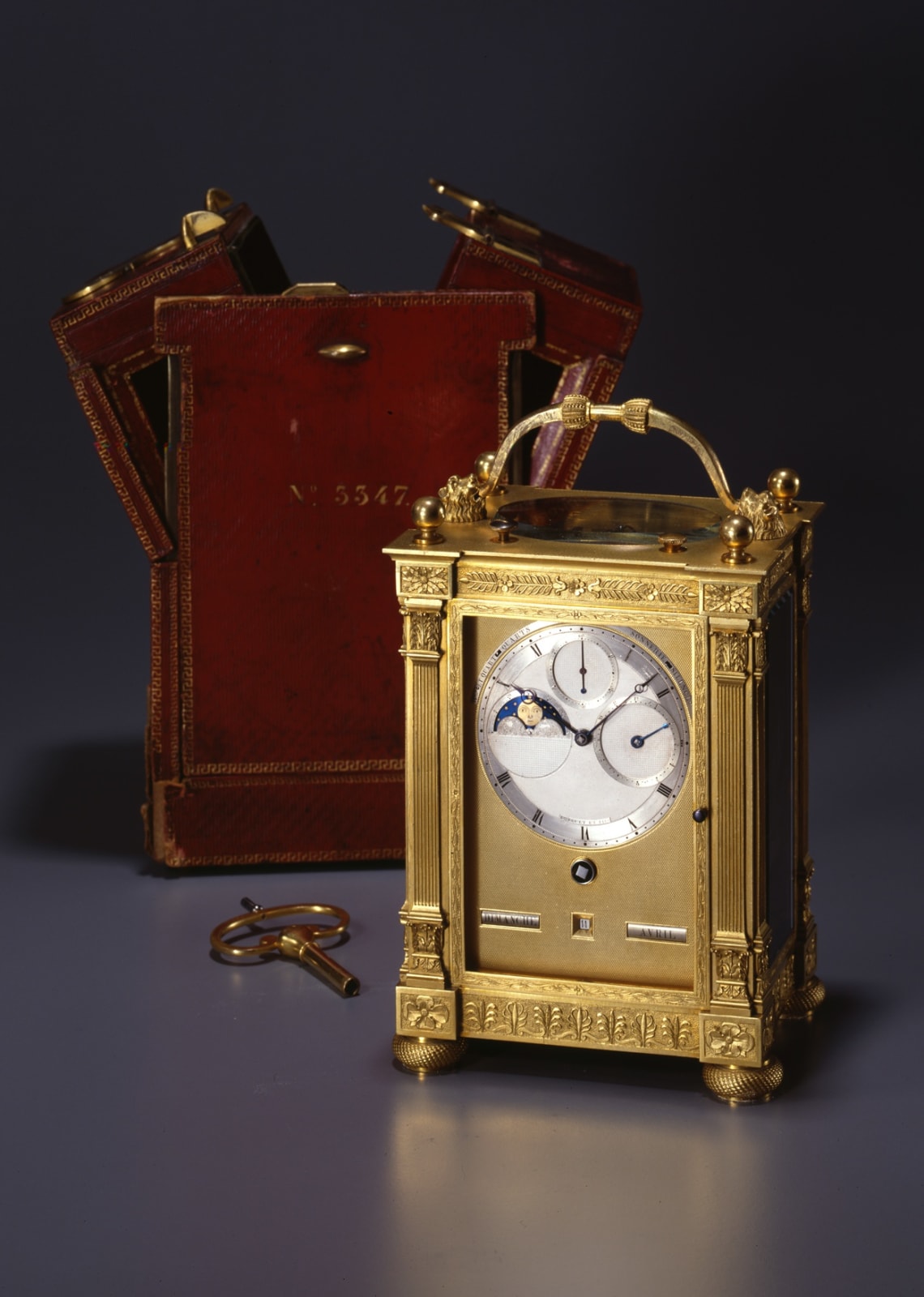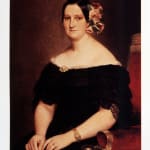
Marie-Christine de Bourbon-Sicilie, Queen of Spain,
Breguet & Fils
Provenance
Sold on 20th August 1831 for 6000 Francs to Maria Cristina de Bourbon-Sicile, Queen of Spain.
Literature
Charles Allix, “Carriage Clocks, their History and Development”, 1974, p. 39, pls. II/2 & 3, illustrating another Breguet carriage clock housed in a similar case, in the Ashmolean Museum, Oxford and p. 47, pls. II/17 & 18, illustrating a more recent carriage clock completed in 1970 by M. Pitou for the House of Breguet of which Allix refers to its “new case in traditional Breguet Empire style used to house a top quality standard carriage clock”. Derek Roberts, “Carriage and Other Traveling Clocks”, 1993, p. 29, pl. 2-3, illustrating this exact clock
A rare and very important Louis-Philippe gilt bronze grande and petite sonnerie striking carriage clock by Breguet et Fils, signed on the silver engine-turned dial Breguet et Fils and also signed and numbered on the backplate Breguet & Fils, no. 3347, accompanied by its original key and gold-tooled red Moroccan leather travelling box stamped on the front No 3347. The dial with Roman numerals and outer ring with a slide for the options, marked H (for the hours) quart/quarts and sonnerie/silence, with three central subsidiary dials for the seconds, age and phases of the moon and alarm with a pair of blued steel hands for the hours and minutes and blued steel pointers for the subsidiary dials and also with three angular apertures below the main dial to indicate the day of the week, date and month. The movement with a lever escapement having a bi-metallic two arm compensation balance with parachute to the top pivot, a single spring barrel which is provided with great wheels to the front and back for the going and striking trains, grande and petite sonnerie striking and repeat on two gongs as well as an alarm. The finely cast case with palmettes and fleurons on a matted ground, the corners with flat fluted Corinthian columns, glazed on all sides, the engine-turned top with a glazed oval aperture, four turned ball finials and an arched handle with chased knop supported on lion head masks, the whole standing on turned bun feet
Paris, date circa 1831
Height 15 cm, width 11 cm, depth 8 cm.
Abraham-Louis Breguet (1747-1823) was one of Europe’s most eminent horologists who was appointed watchmaker to Louis XVI and Marie Antoinette and later to Napoleon. In 1807 he took his son, Antoine-Louis (1776-1858) into partnership and thereafter it was known as Breguet et Fils, when as before the firm was patronised by many illustrious figures such as the Russian Tsar or Maria Cristina de Bourbon-Sicile, Queen of Spain (1806-1878), who purchased the present piece in 1831.
THE QUEEN OF SPAIN
Marie-Christine de Bourbon-Sicile (1806-1879)
Marie Cristine de Bourbon-Sicile, Queen of Spain was bom on April 27,1806 in Naples and died on August 22,1878, Le Havre. She was the daughter of Francis I, King of the Two Sicilies, and was married to Ferdinand VII of Spain in 1829, becoming his fourth wife. Ferdinand VII had no children from his previous three wives. After the birth of their daughter Isabella on October 10, 1830, Marie Cristine convinced her husband to change the law of succession, persuading him to abolish the Act of 1714 that gave preference to all males of the Spanish Royal family over females. By this act he made possible the accession to the throne of their daughter Isabella, an action which deprived the King's brother, Don Carlos, of the Spanish Throne.
Upon Ferdinand's death on September 29,1833, Marie Cristine became Regent until her daughter Isabella II was able to reign. The northern provinces of Spain, however, revolted in favour of Carlos. This Carlist insurrection (1833-1839) forced Marie Cristine to govern with the Liberals who in turn took anti-clerical measures. However, the Regent, whose sympathies were directed towards the Conservatives, tried to separate herself from the Liberals in 1836, provoking a military rebellion (mutiny at La Granja, August 13, 1836) which forced her to accept the Liberal Constitution of Cadiz of March 1812. The Convention of Vergara on August 31, 1839 ended the first of the Carlist wars, and Marie Cristine thought she could reaffirm her authority and proceeded with the dissolution of Cortes on October 18th. However, she stumbled upon the opposition of the progressive General Espartero.
The conspiracies continued and her flagrant affair with her bodyguard Munoz, by whom she had ten children, antagonised many of her supporters. She was forced to resign the regency in 1840 and left for France. She was called back to Spain in December 1843 and took over the regency of her country despite her daughter having reached her majority. Marie Cristine married Isabella to Don Francisco de Assisi, Duke of Cadiz, and her youngest daughter to a son of Louis Philippe, the Duke of Montpensier.
The attempts to participate in political life, the Spanish marriages of convenience, as well as Marie Cristine's constant opposition to constitutional liberty compelled her to go into exile after the revolution of 1854. She retired in Saint-Adresse near Le Havre.
ABRAHAM-LOUIS BREGUET, (1747-1823). FRENCH
France's most eminent horologist, Abraham-Louis Breguet revolutionised the design, techniques and image of watch and clockmaking. His work was luxurious, expensive and of superlative quality .He was appointed watchmaker to Louis XVI and Marie Antoinette, and later to Napoleon. He was also patronised by the Tzars of Russia, the English royal family, the Queen of Naples and of Spain and the high aristocracy. Breguet time pieces can be found worldwide, including London's Biritish Museum, Victoria and Albert Museum, the Guildhall and Buckingham Palace nd in Paris at the Conservatoire des Arts et Metiers.
Breguet was born in Neuchatel, Switzerland. In 1762 he travelled to Paris, serving an apprenticeship to a watchmaker in Versailles; he may also have worked for F. Berthoud (1727-1807) or for J. A. Lepine (1720-1814). Breguet studied mathematics the College Mazarin under Abbe Marie who introduced him to many future clients among the aristocracy. Breguet's marriage to Cecile l'Huillier provided him width enough capital to start his own business, 1775; while contacts he had made through Abbé Marie had almost immediate effect. In 1780 he supplied Duc d'Orleans with a sophisticated self-winding watch, two years later he provided another for Marie Antoinette. Breguet received further finance through his partnership with Xavier Gide, known as Breguet et Cie, (1787-1791). During the heat of the Revolution and under the protection of his friend Marat, Breguet fled to Geneva. During his exile he strengthened contacts and developed new ideas which he immediately implemented upon his return to Paris 1795. One of his first steps was the launch his heaper "souscription" watch, simple to make yet reliable to use.
Breguet applied science and mathematics to the industry, his refinements and innovations considerably added to the art of horology particularly in creating more accurate time keepers and in reducing a watch's thickness. He produced the first “automatic" watch and invented the "parachute", c. 1790 - the first example of shock protection (still used today). He also produced watches for the blind, while his musical watches achieved technological and artistic heights. His style was as radical as it was elegant, he replaced conventional Roman numerals with Arabic, and typically pierced the tips of the hands with a "moon".
In 1807 he took his son, Antoine-Louis (1776-1858) into partnership. The new firm f Breguet et Fils was extremely prosperous as diplomats and aristocrats travelled to Paris during the Napoleonic Campaigns. Breguet also established representativest throughout the world, from London to Madrid and Constantinople to Moscow. During the final decade of his life Breguet received some of the highest accolades; he was appointed a Chevalier de la Legion D'Honneur, a member of the French Board of Longitude, Horologer de la Marine in 1815 and was elected to the Academie Royale des Sciences, 1816. On his death, Breguet et Fils was continued by his son, Antoine-Louis, who was later joined by his own son, Louis-Clement-Frangois (1804-1883), and in turn Louis-Antoine (1851-82) who brought in Edward Brown as successor, while the Breguet family diversified into electricity, telegraph and aeronautics. The current firm, Montres Breguet continues to produce an exclusive range of watches based on the classic designs of its founder, Abraham-Louis Breguet.
Copyright 1994 by Richard Redding Antiques Ltd. All rights reserved!


